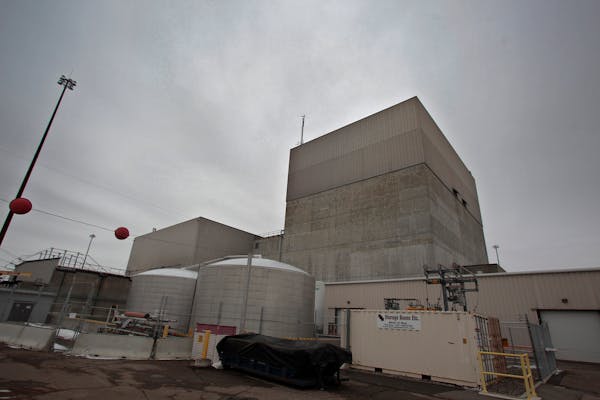The recently revealed leak of radioactive tritium at the Monticello Nuclear Generating Station was the sixth highest recorded among U.S. nuclear power plants.
A monitoring well at the site registered a tritium level of 5 million picocuries per liter, according to a Nov. 22 report from the plant to the state. Only five other plants across the country have registered leaks of higher concentrations, according to a 2021 report from the Nuclear Regulatory Commission, the most recent available.
Tritium, a mildly radioactive form of hydrogen, mixes easily into water but presents no health risk unless it is ingested. It occurs in nature but more commonly as a byproduct of nuclear power production. Xcel has been pumping up and collecting contaminated water, and is also pumping to keep the underground plume of tritium from spreading.
By last week, the concentration in the monitoring well had decreased to 2.47 million picocuries per liter, said Kirk Koudelka, an assistant commissioner at the Minnesota Pollution Control Agency.
The federal limit for tritium in drinking water is 20,000 picocuries per liter, but none of the contaminated water has left the site or reached any drinking water source, including the Mississippi River, state officials and Xcel have said.
The lack of risk to the public was one reason state officials gave for waiting months before publicizing the leak last week. After high levels of tritium were found in November, the leak was patched about a month later — and the public wasn't told the extent of the event until March 16.
"Tritium is a very low risk, and none of that has left the site," said Daniel Huff, assistant commissioner for health protection at the Minnesota Department of Health. "If there had been the potential of any imminent risk, we would have notified folks immediately."
He said he knows some people have criticized the delayed announcement by health officials and the Minnesota Pollution Control Agency.
"We have definitely heard from folks that they want us to, you know, let them know much faster. And we hear that and we get it," Huff said.
State officials got a "first glimpse" in January that the tritium was moving toward the river as the isotope showed up in test results in another well on the plant property, and more monitoring needed to be conducted to understand how the contamination was moving, Koudelka said.
The city of Monticello "learned about the extent of the water leak at the Monticello Plant at the end of February," according to a statement released Friday by Mayor Lloyd Hilgart. Hilgart did not respond to a phone call Tuesday.
The city will also be the site of a long-planned NRC meeting Wednesday night, as the agency collects comments on Xcel's proposal to extend the plant's license. The utility is depending on Monticello, and another generating station at Prairie Island, to meet state requirements for 100% carbon-free energy by 2040.
By volume, Xcel's 400,000-gallon spill was relatively large; the average water tower holds about 1 million gallons.
"400,000 gallons seemed like it should have been discovered sooner," said David Lochbaum, a nuclear safety engineer and consultant. "But to be fair to the company, it could be a longstanding, smaller leak."
The tritium at the Monticello plant leaked from a 3-inch pipe that carried water from the plant's turbine building to its reactor building, with only a half-inch of pipe between the exterior walls.
"It is a very difficult space to get to because the walls on each side are very thick concrete," said Chris Clark, Xcel's president for Minnesota. Workers had to cut through 2 feet of concrete to insert a camera to spot leaks, he said.
The pipe was leaking roughly two gallons per minute – about the speed of a typical kitchen faucet, said Pat Flowers, Xcel's manager of environmental services.
Xcel detected the tritium overload in one of nearly 20 monitoring wells the company built around 2007. The same well showed no evidence of the leak a month earlier. Such groundwater systems were voluntarily installed at nuclear power plants across the country after a particularly well-publicized tritium leak at Exelon Corp.'s Braidwood station in Illinois.
"The silver lining is that these monitoring wells are [in place] and that it is unlikely that leaks will fail to be detected," Lochbaum said.
The nuclear industry's groundwater monitoring initiative came only after legislation was introduced in Congress – by then-Sen. Barack Obama of Illinois – to toughen leak disclosure regulations, Lochbaum said. The bill never passed.
The highest-concentration tritium leak on record happened in 2010 at the Brunswick nuclear plant in North Carolina, where levels reached 19 million picocuries per liter.
Bitcoin's latest 'halving' has arrived. Here's what you need to know
BNSF Railway says it didn't know about asbestos that's killed hundreds in Montana town
Tennessee Volkswagen workers vote on union membership in test of UAW's plan to expand its ranks
Here's how Phish is using the Sphere's technology to give fans something completely different


